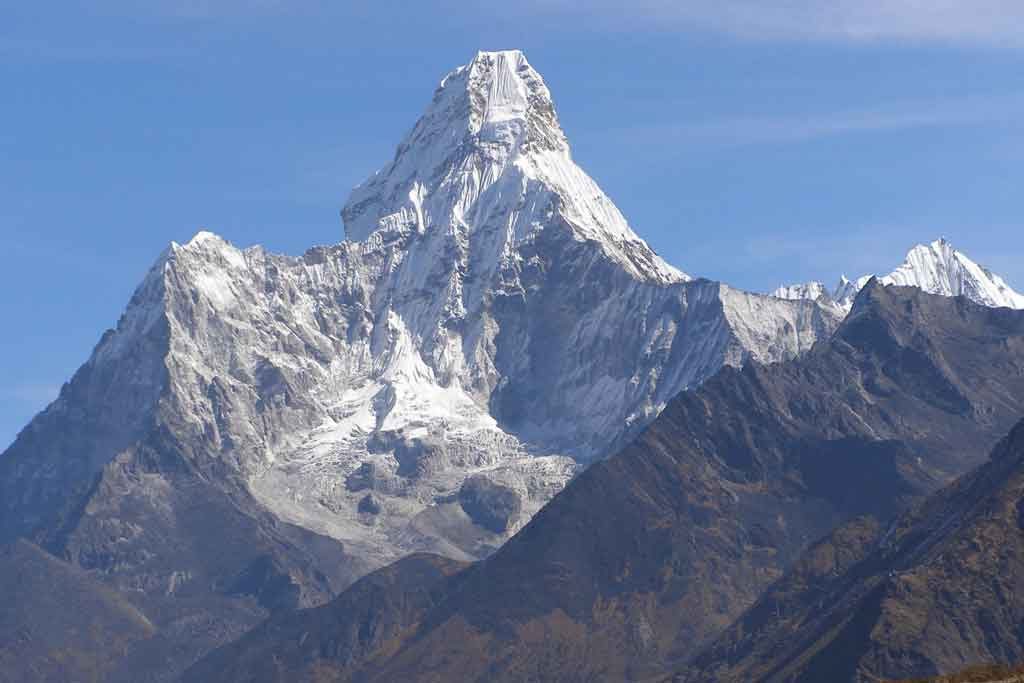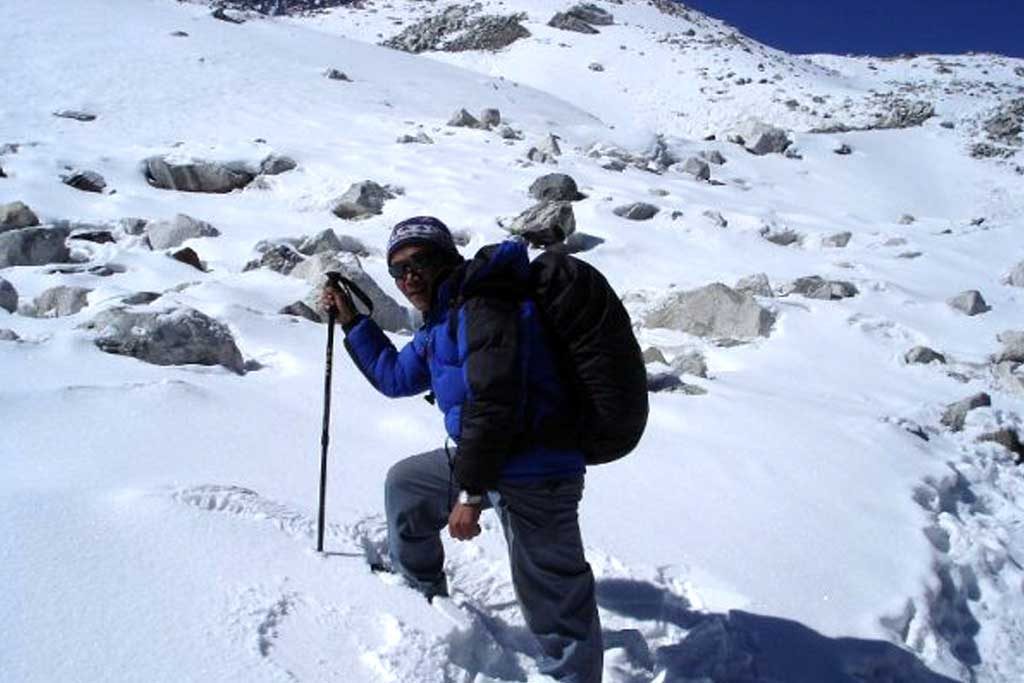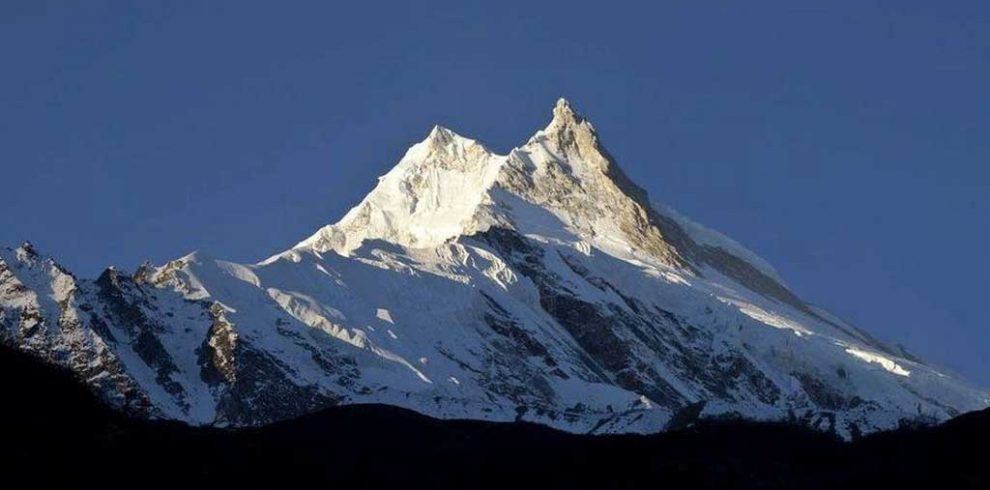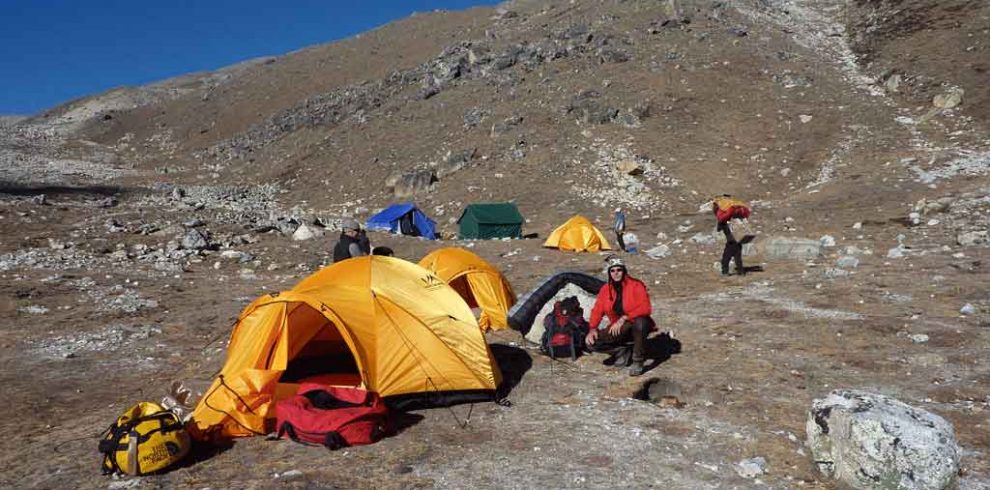The highest peak in the world and magnificent panoramas of the Himalayas, lakes, three high passes of Renjo, Chola and Kongma la are the major attractions of this trek. The Renjo-Chola pass-Everest Base Camp and Kongma la pass trek is for passionate trekkers who are looking for more challenging treks that involve some of the high mountain passes in the world.
The Everest three high passes trek gives an all-round tour of the famous Khumbu Valley of Nepal. This is a hard trek following through the Renjo la Pass (5,340m/17,520ft), Gokyo Ri (5,360m/17,586ft) and over the Chola Pass (5,330m/17,487ft) making a circuit of Tawache (6,367m/20,890ft) and Cholatse (6,440m/21,129ft), Everest Base Camp (5,364m/17,598ft), Kalapatthar (5,545m/18,192ft) and Kongma la Pass (5,535m/18,160ft). This trek refers to as the Everest traverse trek also. The trip highlights adventure, Sherpa culture and their village life.
The summit of Gokyo Ri provides a lifetime memory from where a 360 degree view of Mt. Cho Oyu (8,201m/26,907ft), Mt. Everest (8,848m/29,028ft) and Mt. Makalu (8,463m/27,767ft) is truly panoramic. Additionally, an excursion to the fourth and fifth lakes would be an extra adventure from Gokyo.
The crossing of Chola pass involves a long steady climb up the valley from Thangnak (also spelt as Tagnak) and a drop of about 300 meters into the valley again and then a steep climb of about 500 meters across the loose rocks and boulders to the top.
The trek then continues up to Kalapatthar and Everest Base Camp. After Everest Base Camp, we take a challenge accross the Kongma la pass and reach Chhukung. We trek back to Lukla along the Dudh Koshi valley via Tengboche and Namche Bazaar.
Brief Itinerary:
| Day | Route | Altitude | Duration |
|---|---|---|---|
| 01 | Fly Kathmandu to Lukla, trek to Phakding | 2,610m/8,563ft | Fly: 0.5 hour, Trek: 3-4 hrs |
| 02 | Trek Phakding to Namche Bazaar | 3,446m/11,306ft | Trek: 5-6 hrs |
| 03 | Rest day in Namche Bazaar for acclimatisation | 3,446m/11,306ft | Free time |
| 04 | Trek Namche Bazaar to Thame | 3,820m/12,533ft | Trek: 4-5 hrs |
| 05 | Trek Thame to Lumden | 4,370m/14,337ft | Trek: 4-5 hrs |
| 06 | Trek Lumden to Gokyo crossing over Renjo la pass | 5,340m/17,520ft | Trek: 8-9 hrs |
| 07 | Climb at Gokyo Ri in the morning | 5,360m/17,586ft | Trek: 2-3 hrs |
| 08 | Trek Gokyo to Thangnak | 4,950m/16,241ft | Trek: 3-4 hrs |
| 09 | Trek to Dzonglha crossing over Chola pass | 5,330m/17,487ft | Trek: 6-7 hrs |
| 10 | Trek Dzonglha to Lobuche | 4,910m/16,109ft | Trek: 2-3 hrs |
| 11 | Trek to Everest Base Camp, return trek to Gorakshep | 5,364m/17,598ft | Trek: 7-8 hrs |
| 12 | Trek/Climb to Kalapatthar, return trek to Lobuche | 5,545m/18,192ft | Trek: 5-6 hrs |
| 13 | Trek to Chhukung crossing over Kongma la pass | 5,535m/18,160ft | Trek: 7-8 hrs |
| 14 | Trek Chhukung to Pangboche | 3,930m/12,894ft | Trek: 4-5 hrs |
| 15 | Trek Pangboche to Namche Bazaar | 3,446m/11,306ft | Trek: 5-6 hrs |
| 16 | Return trek Namche Bazaar to Lukla | 2,840m/9,318ft | Trek: 6-7 hrs |
| 17 | Fly Lukla to Kathmandu | 1,350m/4,430ft | Fly: 0.5 hour |
How difficult is Everest Three High Passes Trek?
Everest three passes trekking is a difficult trek and suitable for passionate trekkers. This trek requires walking at least 5-7 hours each day. You might even need to have courage to walk for 8 to 9 hours or more on some days while crossing the high passes.
However, average physical fitness with self confidence is the keys for a successful trek. Regular exercising and jogging for some weeks prior to the trip is a good idea to enhance your strength and ability for this adventure. Your previous hiking experience can be a great asset.
It is important that you consult with your doctor before making decision for this trek if you have any medical problems in the history. Participants with pre-existing medical conditions such as heart, lungs or any other serious disease should inform Trekking Encounters before booking this trek.
Everest Three Passes Trek – Accuracy of Itinerary
We are fully committed to operate this itinerary as printed. However, it may be necessary to make some changes as a result of flight schedules, climatic conditions, limitations of infrastructure, political unrest or other operational factors.
As a consequence, the order or location of overnight stops and trek duration of the day may vary from those outlined on the Everest trekking map. We anticipate your co-operation that you are aware of the events which are beyond our control and have patience.
Best time for Everest Three Passes Trek
The Everest three high passes trek is best to do during spring and autumn. Spring starts from mid of March until mid of June and autumn remains from the beginning of September to November. The views are simply stunning from the different view points along the trail.
It is nice to see the trees bursting into bloom with rhododendrons adding spectacular splash of color to the landscape; turning into a garden from April through early May. October offers the best views of the Himalayan panorama as the summer monsoons have cleared the atmosphere of dust.
The three high passes such as Renjola, Chola and Kongmala remain closed in winter due to snow and ice on them. It is very cold in winter and summer season may not be the right time view-wise. Summer rain and cloud could be the major challenges for the flights to and from Lukla.
IMPORTANT – delayed flights: Please note, flights to and from Lukla can be delayed due to the bad weather. If the flight is delayed for longer, optional helicopter flights are sometimes available at an extra cost. In most cases, it will be a chartered flight.
The extra cost to charter a helicopter will be approximately US $2,500 to $3,000 per helicopter ($500 to $3,000 per person on the basis of number of travellers). The helicopter can carry 4 to 5 persons at a time and the cost is shared amongst the passengers.
Equipment
The Everest three passes trek route starts with moderate temperature to freezing temperatures at higher elevations. So, it’s a good idea to prepare dresses in layers as per the variation of temperatures depending on the season.
T-shirts and shorts are good outfits at lower regions during sunny days. Later, you may need more layers of clothes or warm gears such as gloves, down jackets, warm trousers as the temperature decreases.
Please visit our comprehensive list of equipment to get answers on what to pack.
Baggage: For own comfort travel light. Airlines restrict baggage to 10kg for Lukla sector, but you will be wearing boots and a set of trekking clothes. You may leave some items at the hotel in Kathmandu for your return.
You can store safely the clothing and equipment not necessary on the trek at your hotel. It’s a good idea to leave travel clothes with the hotel laundry so that you have at least one set of clean clothes on your return to civilisation.
High Altitude Precaution
Our Everest three high passes trek itinerary generally allow sufficient time for your body to acclimatise. The best way to avoid any problems is to do everything slowly, walk at a gentle steady pace like a snail and drink plenty of fluid.
Altitude sickness starts with mild headache but there are other signs of Acute Mountain Sickness (AMS) for different people and may include fatigue, dizziness, loss of appetite, nausea or vomiting, difficulty in walking and rattling breath.
Trip Customization with Island Peak
The Everest high pass trek can also be customized with Island Peak for those who are also looking for small peak climbing. Please visit the combined itinerary of Three Passes with Island Peak Climb.
Overview
- The fabulous Renjo la pass (5,340m/17,520ft)
- The challenging Chola pass (5,330m/17,487ft)
- The adventurous Kongma la pass (5,535m/18,160ft)
- The spectacular views from Gokyo Ri
- An excursion trek to the fourth and fifth lakes
- Amazing view of the Khumbu Ice-fall
- Scenic mountain flight to/from Lukla











